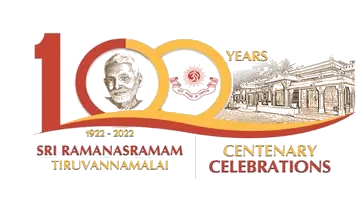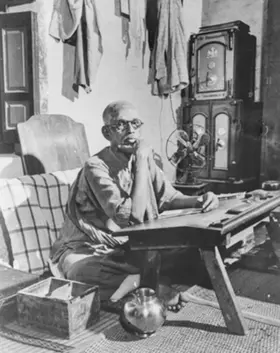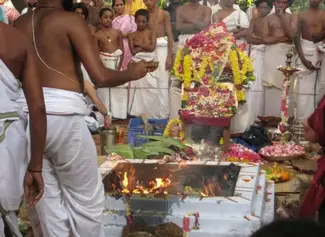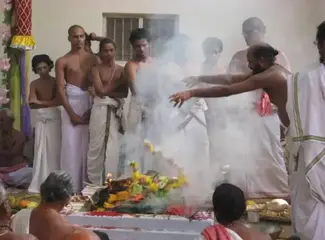Inside this issue
Grace – Garland of Guru's Sayings
Sri Niranjanananda Swami
Sri Vidya Havan – Report
Sri Chakra Meru







Dear Devotees,
With Sri Bhagavan’s Grace we are pleased to publish an eNewsletter from Sri Ramanasramam’s website. The purpose is to bring together devotees of Sri Bhagavan from across the world.
Saranagathi, a monthly eNewsletter, is being developed to help devotees share their experiences, about satsangh, meetings and other events that are held within various centers of Bhagavan Sri Ramana Maharshi around the world.
It is proposed to have one feature article for each issue. The feature article would focus on events that happened during the years between 1879 and 1950 as captured in popular books like Talks with Sri Ramana Maharshi, Letters from Sri Ramanasramam and others, which are available for download from the ashram website.
Our earnest request, to all devotees, satsangh groups and centers is to share with us their events, stories and experiences. Please email them to saranagathi @ sriramanamaharshi.org
Ever Truly In Sri Bhagavan,
President, Sri Ramanansramam.
Sri Niranjanananda Swami
Timeless in Time - Sri Ramana Maharshi
The Aradhana of Sri Niranjanananda Swami, Sri Bhagavan‟s brother and former Sarvadhikari of Sri Ramanasramam, was celebrated at his samadhi on January 22nd, 2008 with special abhishekam and puja. The following article presents a brief sketch of his life, service and devotion to Sri Bhagavan and his many contributions to Sri Ramanasramam.
From 1929 to the beginning of 1953, the management of Sri Ramanasramam was headed by Niranjanananda Swami. He was the younger brother of Ramana. This by itself perhaps would have been sufficient for reverential obeisance to him. During this period there was phenomenal growth of the ashram. When he took over, there were only two huts and Ramana"s hall. Gradually various buildings including the dining hall which is the biggest in structure, came up. The pinnacle of his achievement was the construction of Matrubhuteswara temple, the grand edifice over Mother Azhagammal"s samadhi. The construction, which began on September 1, 1931, took nearly ten years to complete. For Ramana had imposed a strict injunction against raising of any funds in his name or that of the ashram. Ramana"s position was that devotees came to him for solace and counsel on the inner path and that they should not under any circumstances be requested for financial support. Hence Niranjanananda Swami had to complete the task little by little, with great patience and exceptional single-mindedness. He went to Burma to get the best teakwood and to other places to procure quality materials. The services of an outstanding sthapati (authority on temple architecture) Vaidyanatha Sthapati were engaged to be in charge of the construction. It was a labour of love to one who had given birth to the world teacher.
It is also to his credit that the house in which Ramana was born in Tiruchuzhi and the house at which he became an enlightened one in Madurai were acquired through his efforts. In one sense his most important service was to ensure that the ashram extended hospitality and solicitude to the devotees and the visitors. He would take care that they were well fed. Another important aspect was his keenness to ensure that the works of Ramana be available at affordable prices. "The Collected Works of Ramana" in Tamil, "Who am I?", in many languages, the first biography of Ramana, "Sat Darsanam", "Maharshi"s Gospel", were all brought out by him. As a result the ashram became an active centre for spreading Ramana"s teachings.
What marked him out was his total surrender to Ramana whom he regarded as the Supreme One. He had renounced family life and hitched his life to Ramana even while he was at Skandasramam. The old devotees were unanimous in affirming that he regarded his job as an assignment given to him by Ramana to be executed in an attitude of surrender. “Above all his absolute dedication to Bhagavan and his unwavering faith were his mainstay and support.
It is said that he was excessively strict particularly in enforcing the rule that in exchange for free food the inmates should do service to the ashram, be it in the office, kitchen, garden or elsewhere. He was so firm on this that it is said on one occasion Ramana had to humorously intercede on behalf of ‘Sama Thatha’ by referring to the pension rules of the government.
A day prior to his Mahasamadhi, on January 28, 1953, he called his successor T.N.Venkataraman, his family and ashram devotees and said, “Everything belongs to Bhagavan and should be guarded with care and vigilance. Devote yourself heart and soul to the service of the Lord and in return he will shower his grace on you. Be sincere and truthful to the core of your being.”
Sri Chakra Meru
The following extract is from A Sadhu‟s Reminiscences of Ramana Maharshi by Sadhu Arunachala (Major A.W.Chadwick). It describes in detail how Sri Bhagavan has blessed the Sri Chakra Meru installed in the Mathrubhuteswara temple.
Bhagavan was deeply interested in the construction of the Shrine built over his Mother’s tomb. He attended every function in connection with it, placing his hands in blessing on the various objects that were to be enclosed in the walls. At night, when no one was about he would walk round and round the construction consecrating it. That he should take such a demonstrative part in anything has a very deep significance. It was extremely rare and has been doubted by many, but I myself was an eye-witness to these things and can vouch for their truth.
He took a personal interest in the cutting of the Sri Chakra Meru in granite which was installed in the completed temple and is regularly worshipped. This is about one and a half feet square and proportionately high. At the time of the Kumbhabhishekam, on the penultimate night before the sacred water was poured over the images, he personally superintended the installation in the inner shrine. It was an extremely hot night and with three charcoal retorts for melting the cement adding to the heat, it must have been intolerable inside the airless cave of the inner shrine, but for about an hour and a half Bhagavan sat there telling the workmen what to do.

On the last night of the function he went in procession, opening the doors of the new Hall and temple and passing straight up into the Inner Shrine, where he stood for some five minutes with both hands laid on the Sri Chakra in blessing. I happened that night to be at his side the whole time; this was unusual as I deliberately avoided taking prominent part in such things, preferring to watch from the back. Strangely, something made me keep by him on this occasion and on account of this I was able to understand his deep interest in the Temple and especially in the Sri Chakra. It was because of this knowledge that I was instrumental after Bhagavan’s passing, in persuading the Ashram authorities to institute the Sri Chakra Pujas six times a month. The explanation for this unusual action on Bhagavan’s part may be found in the necessity that Siva must be always accompanied by Shakti. The world would stop otherwise. On the only occasion when such a Puja was performed shortly after the dedication of the Temple during the life of Bhagavan, he refused to go for his evening meal but insisted on remaining a witness of it until the end. When someone remarked how magnificent it had been and it would be good thing if such Pujas could be performed regularly, “Yes,” replied Bhagavan, “but who will take the trouble?” The trouble is being taken now and it undoubtedly has the blessings of Bhagavan.
Publisher: V.S.Ramanan
Editorial Team: Ranjani Ramanan, Prashanth Visweswaran, Ravi Ramanan
Email: saranagati@gururamana.org




